(完整word版)英语时态标志词
(完整版)英语中八种常见时态常用时间状语归纳
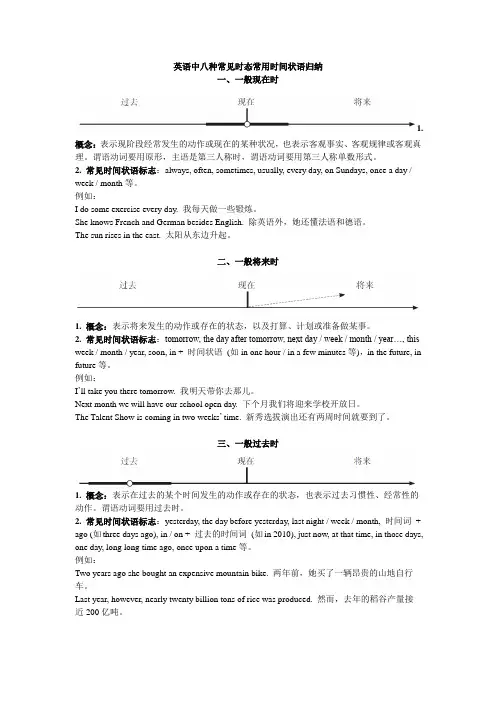
英语中八种常见时态常用时间状语归纳一、一般现在时1. 概念:表示现阶段经常发生的动作或现在的某种状况,也表示客观事实、客观规律或客观真理。
谓语动词要用原形,主语是第三人称时,谓语动词要用第三人称单数形式。
2. 常见时间状语标志:always, often, sometimes, usually, every day, on Sundays, once a day / week / month等。
例如:I do some exercise every day. 我每天做一些锻炼。
She knows French and German besides English.除英语外,她还懂法语和德语。
The sun rises in the east. 太阳从东边升起。
二、一般将来时1. 概念:表示将来发生的动作或存在的状态,以及打算、计划或准备做某事。
2. 常见时间状语标志:tomorrow, the day after tomorrow, next day / week / month / year…, this week / month / year, soon, in + 时间状语(如in one hour / in a few minutes等),in the future, in future等。
例如:I’ll take you there tomorrow. 我明天带你去那儿。
Next month we will have our school open day. 下个月我们将迎来学校开放日。
The Talent Show is coming in two weeks’ time. 新秀选拔演出还有两周时间就要到了。
三、一般过去时1. 概念:表示在过去的某个时间发生的动作或存在的状态,也表示过去习惯性、经常性的动作。
谓语动词要用过去时。
2. 常见时间状语标志:yesterday, the day before yesterday, last night / week / month, 时间词+ ago (如three days ago), in / on + 过去的时间词(如in 2010), just now, at that time, in those days, one day, long long time ago, once upon a time等。
初中英语八大时态基本结构与标志词
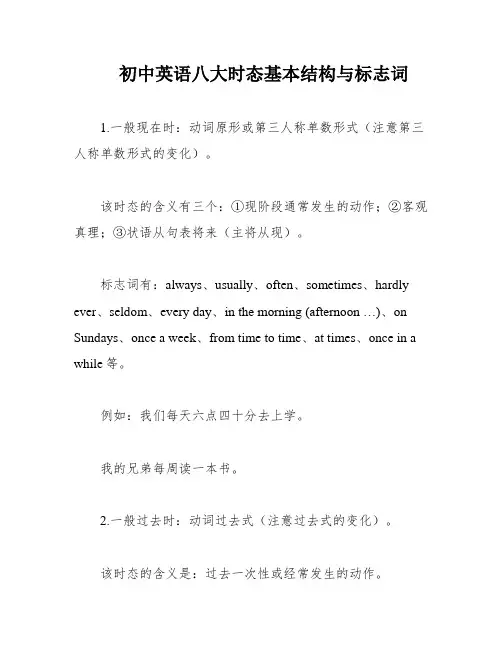
初中英语八大时态基本结构与标志词1.一般现在时:动词原形或第三人称单数形式(注意第三人称单数形式的变化)。
该时态的含义有三个:①现阶段通常发生的动作;②客观真理;③状语从句表将来(主将从现)。
标志词有:always、usually、often、sometimes、hardly ever、seldom、every day、in the morning (afternoon …)、on Sundays、once a week、from time to time、at times、once in a while等。
例如:我们每天六点四十分去上学。
我的兄弟每周读一本书。
2.一般过去时:动词过去式(注意过去式的变化)。
该时态的含义是:过去一次性或经常发生的动作。
标志词有:yesterday、last week、three days ago、the day before yesterday、in 1990、in the 1930s、just now、those days、the other day、once upon a time、at birth、at the age of、one day、recently、when引导表过去的从句等。
例如:我昨天完成了我的工作。
他十天前去了纽约。
3.现在进行时:am/is/are + 动词-ing形式(注意动词-ing形式的变化)。
该时态的含义是:此刻或现阶段正在发生的动作(注意:be always doing表达抱怨或赞扬语气,不表示正在发生的动作)。
标志词有:Look。
Listen!now、right now、at the moment\ time、at this moment\ time、at present、these days、It’s sixo’clock。
Where is your father?等。
例如:看!那个男孩正在和一只猫玩。
现在是八点,XXX一家正在客厅看电视。
英语语法时态表(含标志词)
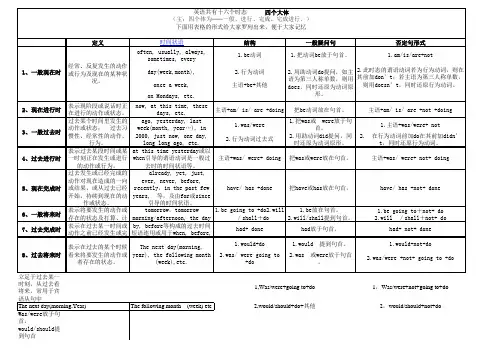
1,Was/were+going to+do 2,would/should+do+其他
3、一般过去时
4、过去进行时
5、现在完成时
把have或has放在句首。
have/ has +not+ done
6、一般将来时 7、过去完成时
1.be放在句首。 2.will/shall提到句首。 had放于句首。 1.would 提到句首。 2.was 或were放于句首 。
1.be going to+not+ do 2.will /shall+not+ do had+ not+ done 1.would+not+do 2.was/were +not+ going to +do 1,Was/were+not+going to+do 2,would/should+not+do
2.用助动词do提问,如主 2.此时态的谓语动词若为行为动词,则在 语为第三人称单数,则用 其前加don’t;若主语为第三人称单数, 则用doesn’t,同时还原行为动词。 does,同时还原为动词原 形。 把be动词放在句首。 1.把was或 were放于句 首。 2.用助动词did提问,同 时还原为动词原形。 把was或were放在句首。 主语+am/ is/ are +not +doing 1.主语+was/were+ not 2. 在行为动词前加do在其前加didn’ t,同时还原行为动词。 主语+was/ were+ not+ doing
8、过去将来时
表示在过去的某个时候 The next day(morning, 看来将要发生的动作或 year), the following month 者存在的状态。 (week),etc.
(完整word版)英语时态标志词
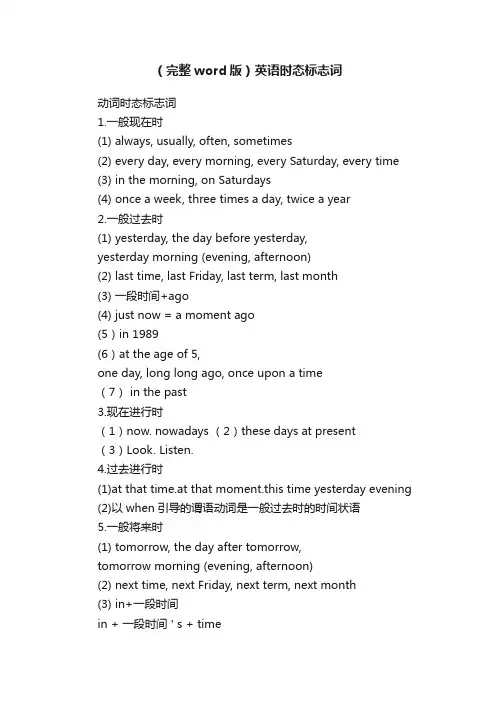
(完整word版)英语时态标志词动词时态标志词1.一般现在时(1) always, usually, often, sometimes(2) every day, every morning, every Saturday, every time(3) in the morning, on Saturdays(4) once a week, three times a day, twice a year2.一般过去时(1) yesterday, the day before yesterday,yesterday morning (evening, afternoon)(2) last time, last Friday, last term, last month(3) 一段时间+ago(4) just now = a moment ago(5)in 1989(6)at the age of 5,one day, long long ago, once upon a time(7) in the past3.现在进行时(1)now. nowadays (2)these days at present(3)Look. Listen.4.过去进行时(1)at that time.at that moment.this time yesterday evening(2)以when引导的谓语动词是一般过去时的时间状语5.一般将来时(1) tomorrow, the day after tomorrow,tomorrow morning (evening, afternoon)(2) next time, next Friday, next term, next month(3) in+一段时间in + 一段时间 ' s + time(4) soon = right away = at once(5) by the end of + 将来时间6.过去将来时(1)the next time Friday term month(2)the following month (week…),7..现在完成时(1) already, yet, ever, never, just, before(2) for + 一段时间,since + 过去某一点时间since +从句(一般过去式);since + 一段时间 + agoin / during the past / last + 一段时间(3)recently ,lately(4)so far8..过去完成时(1).by, by the time (of), by the end of + 过去时间(2)when. before. after…….+过去时间(3)up till then (直到那时); up until last night(直到昨晚)等。
英语16种时态的标志词
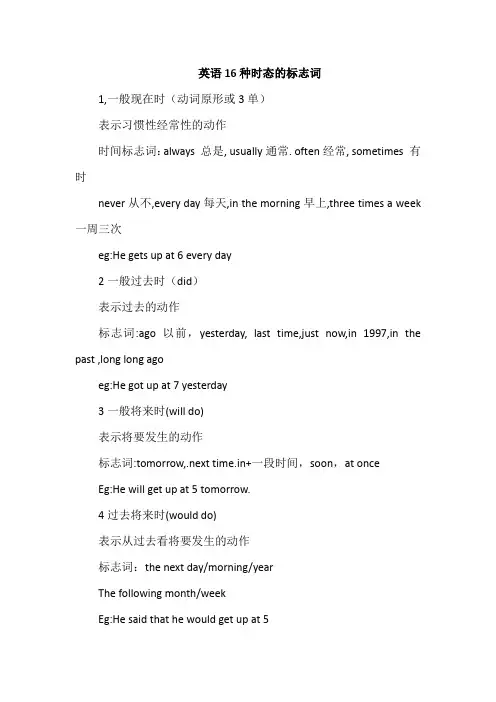
英语16种时态的标志词1,一般现在时(动词原形或3单)表示习惯性经常性的动作时间标志词:always 总是, usually通常. often经常, sometimes 有时never从不,every day每天,in the morning早上,three times a week 一周三次eg:He gets up at 6 every day2一般过去时(did)表示过去的动作标志词:ago以前,yesterday, last time,just now,in 1997,in the past ,long long agoeg:He got up at 7 yesterday3一般将来时(will do)表示将要发生的动作标志词:tomorrow,.next time.in+一段时间,soon,at onceEg:He will get up at 5 tomorrow.4过去将来时(would do)表示从过去看将要发生的动作标志词:the next day/morning/yearThe following month/weekEg:He said that he would get up at 5进行时,四种5现在进行时(am/is/are doing)表示此时此刻正在进行的动作标志词:now,look,listen,at 1 o’clockEg:He is having breakfast now6过去进行时(was/were doing)表示过去某一时刻正在进行的动作标志词:this time yesterday,at that time, then, 具体的时间点Eg:I was doing my homework at 8 yesterday7将来进行时(will be doing)表示将来某一时刻正在进行的动作标志词:this time tomorrow,at that time , 具体的时间点Eg:I will having a meeting at 8 next Monday8过去将来进行时(would be doing)表示从过去某一时间看,将要进行的动作Eg He asked me not to come at 8 because he would be having a meeting then完成时,四种9现在完成时(have/has done)表示到说话时,已经完成的动作标志词:already已经,recently最近,for+时间段,Eg:I have already finished my homework10 过去完成时(had done)表示过去某一时刻说话前,已经完成的动作标志词:before+过去的时间点,when引导的状语从句,by the end of +过去的时间Eg:He said that he had finished his homework11将来完成时(will have done)表示某个时间点之前要完成的动作Eg :we will have finished Book One by the end of this term.12过去将来完成时(would have done)表示从过去某个时间看,将要再过去某个时间完成的动作标志词:by the end of +将来的时间,before +将来的时间,。
常用英语8种时态标志词
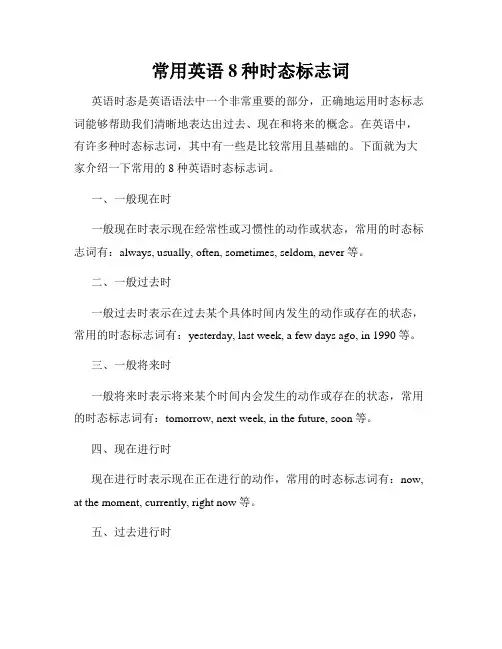
常用英语8种时态标志词英语时态是英语语法中一个非常重要的部分,正确地运用时态标志词能够帮助我们清晰地表达出过去、现在和将来的概念。
在英语中,有许多种时态标志词,其中有一些是比较常用且基础的。
下面就为大家介绍一下常用的8种英语时态标志词。
一、一般现在时一般现在时表示现在经常性或习惯性的动作或状态,常用的时态标志词有:always, usually, often, sometimes, seldom, never等。
二、一般过去时一般过去时表示在过去某个具体时间内发生的动作或存在的状态,常用的时态标志词有:yesterday, last week, a few days ago, in 1990等。
三、一般将来时一般将来时表示将来某个时间内会发生的动作或存在的状态,常用的时态标志词有:tomorrow, next week, in the future, soon等。
四、现在进行时现在进行时表示现在正在进行的动作,常用的时态标志词有:now, at the moment, currently, right now等。
五、过去进行时过去进行时表示过去某个时间内正在进行的动作,常用的时态标志词有:at that time, while, when等。
六、将来进行时将来进行时表示将来某个时间内将正在进行的动作,常用的时态标志词有:this time tomorrow, next Sunday, by this time等。
七、过去完成时过去完成时表示在过去某个时间之前已经完成的动作,常用的时态标志词有:before, by the time, already, just等。
八、将来完成时将来完成时表示在将来某个时间之前将已经完成的动作,常用的时态标志词有:by this time tomorrow, by the end of next month, in a year等。
总结来说,正确地运用这些时态标志词能够帮助我们清晰地表达不同时间内的动作或状态,增加文章的逻辑性和连贯性,是我们学习英语时态的重要组成部分。
各种时态的标志词汇总
各种时态的标志词汇总以下是 9 条关于各种时态标志词汇总的内容:1. 一般现在时呀,那标志词可不少呢,像 always(总是)、usually (通常)、often(经常)、sometimes(有时)、every day(每天)等。
比如:I always go to school on foot every day. (我每天总是步行去上学。
)2. 现在进行时哟,常用的标志词有 now(现在)、right now(此时此刻)、at the moment(此刻)等。
看呀,He is playing basketball now. (他现在正在打篮球呢。
)3. 一般过去时嘿,常见标志词有yesterday(昨天)、last week(上周)、ago(以前)等。
想想,I played the piano yesterday. (我昨天弹钢琴了呀。
)4. 过去进行时啦,那标志性的有 when/while 引导的从句等。
哎呀,I was reading a book while he was watching TV. (当他在看电视的时候我正在读一本书呢。
)5. 现在完成时哇,标志词像 already(已经)、yet(还)、for 和 since 等。
瞧瞧,I have already finished my homework. (我已经完成我的作业啦。
)6. 过去完成时呢,常用 before(在……之前)等。
就像,He had left before I arrived. (在我到达之前他已经离开了。
)7. 将来时呀,will(将要)、be going to(打算)这都是标志词哦。
例如,I will go to Beijing next week. (我下周将要去北京呀。
)8. 过去将来时嘿,会有 would(会)等。
类似,He said he would come here the next day. (他说他第二天会来这里哟。
英语时态标志词
英语时态标志词编辑整理:尊敬的读者朋友们:这里是精品文档编辑中心,本文档内容是由我和我的同事精心编辑整理后发布的,发布之前我们对文中内容进行仔细校对,但是难免会有疏漏的地方,但是任然希望(英语时态标志词)的内容能够给您的工作和学习带来便利。
同时也真诚的希望收到您的建议和反馈,这将是我们进步的源泉,前进的动力。
本文可编辑可修改,如果觉得对您有帮助请收藏以便随时查阅,最后祝您生活愉快业绩进步,以下为英语时态标志词的全部内容。
动词时态标志词1.一般现在时(1)always, usually, often, sometimes(2) every day, every morning,every Saturday,every time (3)in the morning,on Saturdays(4)once a week, three times a day,twice a year2.一般过去时(1)yesterday, the day before yesterday,yesterday morning (evening, afternoon)(2) last time, last Friday, last term,last month (3) 一段时间+ago(4)just now = a moment ago(5)in 1989(6)at the age of 5,one day,long long ago,once upon a time(7)in the past3。
现在进行时(1)now。
nowadays (2)these days at present(3)Look. Listen。
4.过去进行时(1)at that time.at that moment。
this time yesterday evening (2)以when引导的谓语动词是一般过去时的时间状语5.一般将来时(1)tomorrow,the day after tomorrow,tomorrow morning (evening, afternoon)(2) next time,next Friday, next term,next month(3) in+一段时间in + 一段时间' s + time(4)soon = right away = at once(5)by the end of + 将来时间6.过去将来时(1)the next time Friday term month(2)the following month (week…),7..现在完成时(1) already, yet,ever,never, just, before(2) for + 一段时间,since + 过去某一点时间since +从句(一般过去式);since + 一段时间+ agoin / during the past / last + 一段时间(3)recently ,lately(4)so far8。
(完整word版)八大时态标志词
(完满word版)八大时态标志词一般现在时标志词:every day,evry Sunday,often,always,usually,sometimes ,on Sundays, on weekdays等等。
一般过去时标志词:ago, yesterday,the day before yesterday,last week/year/night/month...,in 1989, just now,at the age of ,one day ,ago, long ago,once upon a time,(从前,许久从前)then( 那时 ), on that day (在那天) ,一般将来时标志词:soon, tomorrow, the day after tomorrow (后天),this evening/afternoon/yearbefore long( 不久今后),next year/month/week/summer , in the future,some day(将来的某一天 ) ,in two weeks/days/years现在进行时标志词:now. Look . Listen. these days,at that time.at that moment.this time,yesterday evening过去进行时标志词:at that time. at that moment. this time yesterday evening 等;也许与when, while, as 引导的过去时间状语连用。
现在完成时标志词:already(用于必定句), yet (用于否定,疑句), just, before, recently,still, lately,never, ever, never, twice, on several occasion, in the past few days/weeks/months/years, (up to)these fewdays/weeks/months/years, this morning/week/month/year, just,up to present, so far, up to now, till now, since+过去完成志:by, by the time (of), by the end of +去;when. before.after ⋯⋯ .+ 去;up till then ( 直到 ); up until last night( 直到昨晚)等;already, just, ever, yet等。
英语时态结构_标志词总结
英语时态结构,标志词总结⑴、一般现在时结构:主+be(am/is/are)+其他/ 主+实义动词+其他/ 主+情态动词+动原+其他标志词:often, always, usually, sometimes , every week (day/y ear/month…), once a week, on Sundays, on weekdays,from time to time⑵、一般将来时结构:主+will/shall+其他/主+be going to +其他/主+be+动-ing+其他…(现在进行时表示将来)标志词:tomorrow, in the future, next week , next Sunday, the day after tomorrow,in+ 一段时间,soon,from now on⑶、一般过去时结构:主+be(was/ were)+其他/ 主+动词过去式+其他/标志词:一段时间+ago, yesterday, in 1945,at that time,once,during the war,before, in the past , the day before yest erday, last week(year/ night/ month…), just now, at the age of 5, one day, long long ago, once upon a time,this morning,a moment ago⑷、现在完成时结构:主+have/has+动词过去分词+其他标志词:ever, never, since, already, yet, just, before, twice, once ,three times, at the moment, at present/for+时间段;since+时间点/常见的副词:lately,recently,up to now, till now, so far, these days,in the past few years(months /weeks/days)⑸、现在进行时结构:主+be(am/is/are)+动词现在分词+其他标志词:now, at the moment !at this time ,these days ,Look! Listen!⑹、过去进行时结构:主+be(was/ were)+动词现在分词+其他标志词:at that moment, at this time of yesterday, at eight last night,at 8:00am yesterday,at this time last night ,at that time⑺、过去完成时结构:主+had+动词过去分词+其他标志词:by the end of last year(term, month…),过去完成时常用在told,said,knew,heard等词后的宾语从句或间接引语中,这时从句中的动作发生在主句表示的过去的动作之前。
- 1、下载文档前请自行甄别文档内容的完整性,平台不提供额外的编辑、内容补充、找答案等附加服务。
- 2、"仅部分预览"的文档,不可在线预览部分如存在完整性等问题,可反馈申请退款(可完整预览的文档不适用该条件!)。
- 3、如文档侵犯您的权益,请联系客服反馈,我们会尽快为您处理(人工客服工作时间:9:00-18:30)。
动词时态标志词1.一般现在时(1) always, usually, often, sometimes(2) every day, every morning, every Saturday, every time(3) in the morning, on Saturdays(4) once a week, three times a day, twice a year2.一般过去时(1) yesterday, the day before yesterday,yesterday morning (evening, afternoon)(2) last time, last Friday, last term, last month(3) 一段时间+ago(4) just now = a moment ago(5)in 1989(6)at the age of 5,one day, long long ago, once upon a time(7) in the past3.现在进行时(1)now. nowadays (2)these days at present(3)Look. Listen.4.过去进行时(1)at that time.at that moment.this time yesterday evening(2)以when引导的谓语动词是一般过去时的时间状语5.一般将来时(1) tomorrow, the day after tomorrow,tomorrow morning (evening, afternoon)(2) next time, next Friday, next term, next month(3) in+一段时间in + 一段时间 ' s + time(4) soon = right away = at once(5) by the end of + 将来时间6.过去将来时(1)the next time Friday term month(2)the following month (week…),7..现在完成时(1) already, yet, ever, never, just, before(2) for + 一段时间,since + 过去某一点时间since +从句(一般过去式);since + 一段时间 + agoin / during the past / last + 一段时间(3)recently ,lately(4)so far8..过去完成时(1).by, by the time (of), by the end of + 过去时间(2)when. before. after…….+过去时间(3)up till then (直到那时); up until last night(直到昨晚)等。
(4)already, just, ever, yet 等英语单选常见时态类标志词1.It’s the first time that……….(从句中用现在完成时)It was for the first time that………(强调句,对状语for the first time进行强调)It’s (high) time that……..(从句中用过去时或should do)2.It’s the same with sb. / So it is with sb.表示某人也如此(用于前句中既有肯定又有否定或两个不同类的谓语动词)3.…be about to do / be doing……when…….正要做/正在做……就在那时…….4.A is twice / three times as +原级+as BA is twice / three times the n. of BA is twice / three times +比较级+than B5.It’s a waste of time / money doing / to do…It’s no use / good doing………It’s possible / probable / (un) likely that……….It makes great / no sense to do……做某事很有/没意义6.There’s no use / good doing…….There’s no sense / point (in) doing……There is no need for sth. / to do…….There is (no) possibility that…………(同位语从句)7.The+比较级…….., the+比较级………越……..,越…….注意:前半句为从句,用一般现在时代替将来时;8.It seems / appears ( to sb. ) that sb…….在某人看来某人………= Sb. seems / appears to be // to do / to be doing / to have done……..It seems / looks as if……….好象/似乎……..9.It (so) happened that sb. ……..某人碰巧……..= Sb. happened to be / to do / to be doing / to have done….. 10.It is said / thought / believed / hoped / supposed …….that sb………=Sb. is said to be / to do / to be doing / to have done……….注意:这种句型里如带动词hope则不能变成简单句,因为hope sb. to do结构11.loading...12…….such…….that…….如此…….以致于(引导结果状语从句)…….such……..as……像……..的这种……(as为关系代词,引导定语从句,在从句里充当主、宾、表)13. Do you mind if I do sth.? / Would you mind if I did sth.?14. The chance is that……../ (The )Chances are that……….很可能…….15.Check / Make sure / See to it / See that……..(从句中常用一般现在时) 确信/务必……..16. depend on it that……..取决于see to it that…….负责/设法做到…….注意:除了except / but / in等介词可以直接接that从句,其它介词后必须用it做形式宾语;17.It is / was +介词短语/ 从句/ 名词/代词等+that………How / When / Where / Why is / was it that………..?注意:此句型为强调句,当被强调的为表示人的词时,还可用who 连接;强调主语时,从句后的谓语动词应与前面的主语保持一致;注意与定语从句的区别)18.How is it that……..How come+从句?How does / did sth. come about?( How did it come about that…….?)19.There seems / appears / happens to bemust be / can’t be / is (are, was, were) said to beis (are, was, were) thought to be…….表示“.似乎有/碰巧有/一定有/不可能有/ 据说有/认为有……..”介词(如of )there being want / wish / expect there to be要/希望/期待有……..adj. / adv. enough for there to be…….足够…….会有…….注意:there being / there to be为there be的非谓语形式;It is said / thought that there is / are……=There is / was / are / were said (thought) to be…….如:I have never dream of there being such a good chance for me. It won’t be cold enough for there to be a frost tonight. 20. 疑问词+插入语+陈述语序?Who do you think he’ll have attend the meeting?21. But for + n. / pron., sb. / sth. would (not) have done…..要不是…….,某人早就…… (表示虚拟语气)=If it had not been for…..,……./ If there had not been …….,……..22. It won(’t) be long before +从句(从句中用一般现在时)不久/很久就要…….It was (not) long before+从句(从句中用一般过去时)不久/很久才……..23.Those who………….(从句及主句中谓语动词用复数形式)Anyone who…………=Whoever………..(从句及主句中谓语动词用单数形式)24主句(一般现在时或过去时)…...when从句….(might / should do 或might / should have done)表示”对比”,意思为“本该……(可)而却”,主句中为陈述语气,从句里为虚拟语气,Why are you here when you should be in school?你本该上学的怎么在这儿?25.There is ./ Sb. have no doubt that………(同位语从句,that不可省略)There is / Sb. have some doubt whether……..(同位语从句不可用if)Sb. doubt if / whether…….Sb. don’t doubt that………26.immediately / directly / instantly / the moment +从句on / upon + n. / doingNo sooner had sb. done than …….(过去时)Hardly had sb. done when……..(过去时)注意:这几个结构都表示“一…….就”;27.every time / each time /the last time / the first time / next time +从句(名词性短语引导时间状语句)anywhere / everywhere +从句(相当于wherever引导的地点状语从句)You can go anywhere you like.Next time you come, please bring your son along.28.If only / I wish +从句 (用过去类时态)表示虚拟语气, “要是…….就好了”“但愿……就好了!”29.C onsidering + n. 或 pron. 或 that从句 /Seeing that……….考虑到/鉴于…….Given + n. / pron作状语,表示“在有……的情况下”“如果有”“假定”,有时也表示”考虑到”Seeing (that) he refused to help us, there is no reason why we should help him now.Given good health, I hope to finish the work this year.Given their inexperience / that they are inexperienced, they’ve done a good job.30.T here was a time when…….曾经有那么一度……….31.other than与no, not, none等否定词连用,表示肯定意思,如: It was none other than Mr. Smith.这正是Smith先生.32. Not until…….did / do/ does / will sb. do……It was / is not until ……that sb………33.It’s (un) like sb. to do / to have done……做某事很像某人/ 做某事可不像某人34.It remains to be seen whether……..是否…….还有待于看.(不用that, if作连接词)35.It only remains for sb. to do……剩下的只是要某人做某事.We’ve got everything ready.It only remains for you to come to dinner.35.One moment……., and now………刚才一会儿还在做……而现在却……..37.Not all / both / everyone………表示部分否定38. Such is / are……..这(些)就是……. (谓语动词单复数由后面名词决定)39.I’d rather (not) do / have done……我宁愿…..I’d rather +从句(从句中用过去时或过去完成时)40. It’s important / necessary / strange / surprising….+that……(用陈述语气或should do)41. I like / hate / appreciate it that / when等从句(it表示后面从句的这种情况)I appreciate it if you will give me a hand.42. By the time +从句(一般现在时/过去时),主句(将来完成时/过去完成时)43………., as is often the case with sb. / as is usual with sb.(as引导非限制性定语从句)44 in case / lest / for fear that…….(从句中用陈述语气或should do)45.While置于句首可表示As long as 或 AlthoughWhile there is life there is hope.While I admit his good points, I can see his bad ones. 46.can not ( never) ……too +adj. (adv. ) / adj. (adv.) + enough “越……越好”“非常”too + adj. ( anxious / eager / willing / ready / glad等)+to do…表示肯定意思I can’t thank you enough.我非常感激你.He was too glad to see his father.=He was very glad to see his father.47. not / neve等表示否定的词与比较级连用表示最高级,-----Do you agree with his suggestion?-------I can’t agree more.48. What if……..要是…….怎么办?What if he doesn’t come tomorrow?49.more……..than与其…….不如……..He is more nervous than frightened.50. It is / has been +一段时间+since从句(从句中如为延续性动词,则实际表示的意思相反)It is two years since he drank.他不喝酒已两年了.。
